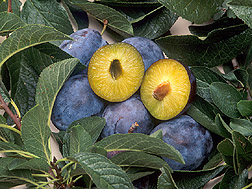This page has been archived and is being provided for reference purposes only. The page is no longer being updated, and therefore, links on the page may be invalid.
Read the magazine story to find out more. | Virus-Resistant Plum Trees--Ready and WaitingBy Judy McBrideSeptember 17, 2001 Three plum trees standing in Agricultural Research Service orchards could help prevent a nasty fruit virus from becoming established in the United States as it is in Europe and elsewhere. The trees--simply dubbed “C5"--are virtually immune to all major strains of plum pox virus. Also known as sharka, plum pox virus deforms or blemishes plums, peaches, apricots and almonds, making the fruit unmarketable. C5 was developed by ARS horticulturist Ralph Scorza. It looks very similar to its female parent, Bluebyrd, a commercial cultivar developed by Scorza through traditional breeding. And its fruit tastes the same. The difference is that C5 was given a gene that prevents plum pox virus from multiplying. First discovered in Adams County, Pa., nearly two years ago, plum pox recently surfaced in two more Pennsylvania counties--York and Cumberland. Fortunately, the Pennsylvania strain of the virus is less aggressive than other strains found in Europe. That could buy some time for the ARS-developed tree to reach the market. Because C5 was genetically engineered, ARS technology transfer specialists can’t say when it will be available for commercial use. It will have to pass a strict regulatory process for genetically modified organisms. Moreover, the pieces of DNA, as well as the techniques required to make them work, are all from different sources, and several are patented. That’s why ARS filed a patent on C5 this month--to encourage a partner to pull all these threads together toward commercialization, according to an ARS patent advisor. Michel Ravelonandro at INRA, the French counterpart of ARS, provided the plum-pox- resistance gene. Dennis Gonsalves at Cornell University in Geneva, N.Y., provided a souped-up vector--an Agrobacterium--for inserting the gene. An article on ARS plum pox research is in the September issue of Agricultural Research magazine. ARS is the U.S. Department of Agriculture’s principal scientific research agency. |

